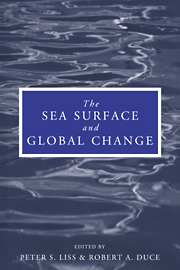Book contents
- Frontmatter
- Contents
- List of contributors
- Preface
- 1 Report Group 1 – Physical processes in the microlayer and the air–sea exchange of trace gases
- 2 Report Group 2 – Biological effects of chemical and radiative change in the sea surface
- 3 Report Group 3 – Photochemistry in the sea-surface microlayer
- 4 Transport processes in the sea-surface microlayer
- 5 The role of organic films in air–sea gas exchange
- 6 Bubbles and their role in gas exchange
- 7 The physical chemistry of air–sea gas exchange
- 8 The sea-surface microlayer and its effect on global air–sea gas transfer
- 9 Chemistry of the sea-surface microlayer
- 10 Biophysics of the surface film of aquatic ecosystems
- 11 Biological effects of chemicals in the sea-surface microlayer
- 12 Neuston of seas and oceans
- 13 Photochemistry in the sea-surface microlayer
- 14 Hydrocarbon breakdown in the sea-surface microlayer
- 15 Applications of laser technology and laser spectroscopy in studies of the ocean microlayer
- 16 Remote sensing of the sea-surface microlayer
- Index
3 - Report Group 3 – Photochemistry in the sea-surface microlayer
Published online by Cambridge University Press: 24 September 2009
- Frontmatter
- Contents
- List of contributors
- Preface
- 1 Report Group 1 – Physical processes in the microlayer and the air–sea exchange of trace gases
- 2 Report Group 2 – Biological effects of chemical and radiative change in the sea surface
- 3 Report Group 3 – Photochemistry in the sea-surface microlayer
- 4 Transport processes in the sea-surface microlayer
- 5 The role of organic films in air–sea gas exchange
- 6 Bubbles and their role in gas exchange
- 7 The physical chemistry of air–sea gas exchange
- 8 The sea-surface microlayer and its effect on global air–sea gas transfer
- 9 Chemistry of the sea-surface microlayer
- 10 Biophysics of the surface film of aquatic ecosystems
- 11 Biological effects of chemicals in the sea-surface microlayer
- 12 Neuston of seas and oceans
- 13 Photochemistry in the sea-surface microlayer
- 14 Hydrocarbon breakdown in the sea-surface microlayer
- 15 Applications of laser technology and laser spectroscopy in studies of the ocean microlayer
- 16 Remote sensing of the sea-surface microlayer
- Index
Summary
Introduction
Due to the enrichment of chemicals and biota within the sea-surface microlayer, there is the widely held presumption that the surface microlayer could act as a highly efficient and selective microreactor, effectively concentrating and transforming materials brought to the interface from the atmosphere and oceans by physical processes. Rapid photochemical, chemical, and biological reactions within the microlayer could produce a variety of interesting feedbacks. For example, photochemical reactions might destroy (or produce) surface-active species, thereby altering surface wave damping and gas exchange rates. Elevated levels of highly reactive intermediates produced within this zone could present a ‘reaction barrier’ to the transport of some chemicals and trace gases across the air–sea interface, thus affecting their flux to the atmosphere or ocean. Further, reactions occurring within the microlayer potentially could enhance (or deplete) the surface concentrations of certain gases relative to those of bulk seawater, chemically modify compounds during their transport across the interface, alter the redox state, speciation and biological availability of trace metals deposited by the atmosphere to the interface, as well as influence the types and distributions of microlayer materials introduced to the atmosphere by bubble injection and to the deep ocean by particle settling.
Although these processes are very intriguing and potentially of great importance, in many instances evidence supporting the existence of them is lacking.
- Type
- Chapter
- Information
- The Sea Surface and Global Change , pp. 71 - 92Publisher: Cambridge University PressPrint publication year: 1997
- 6
- Cited by

